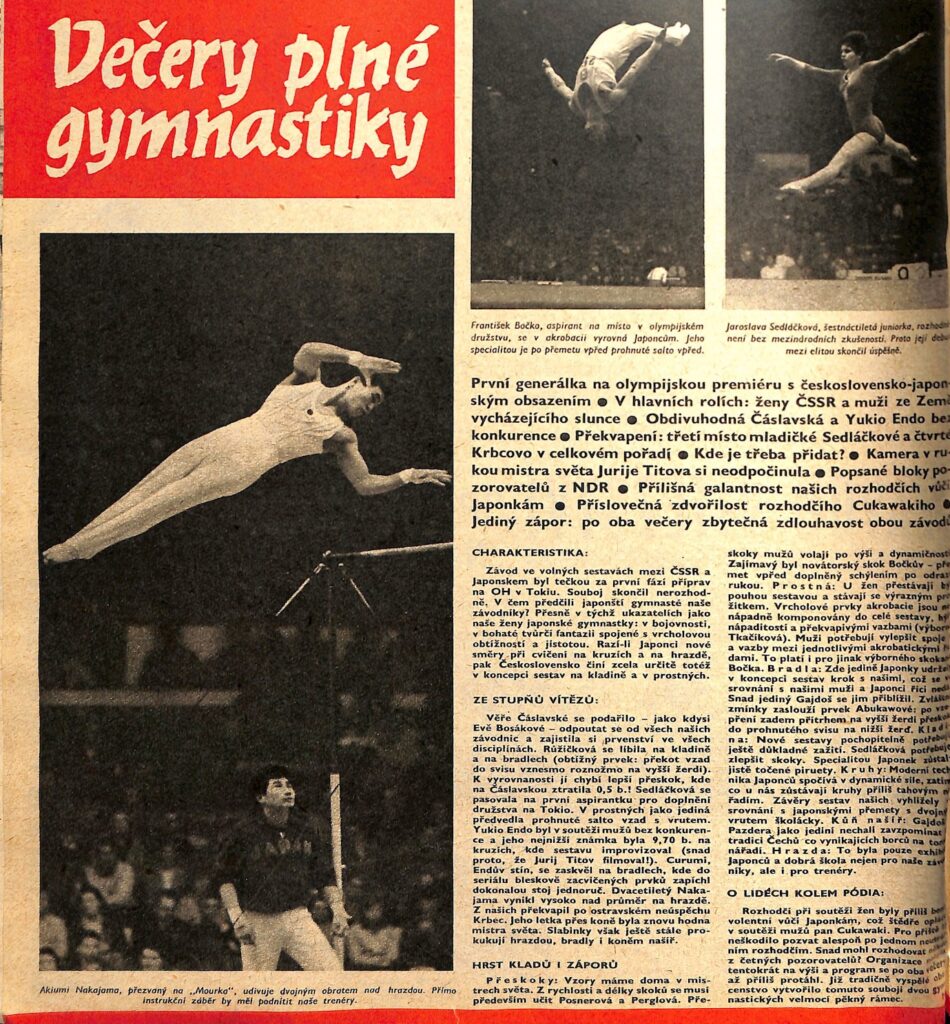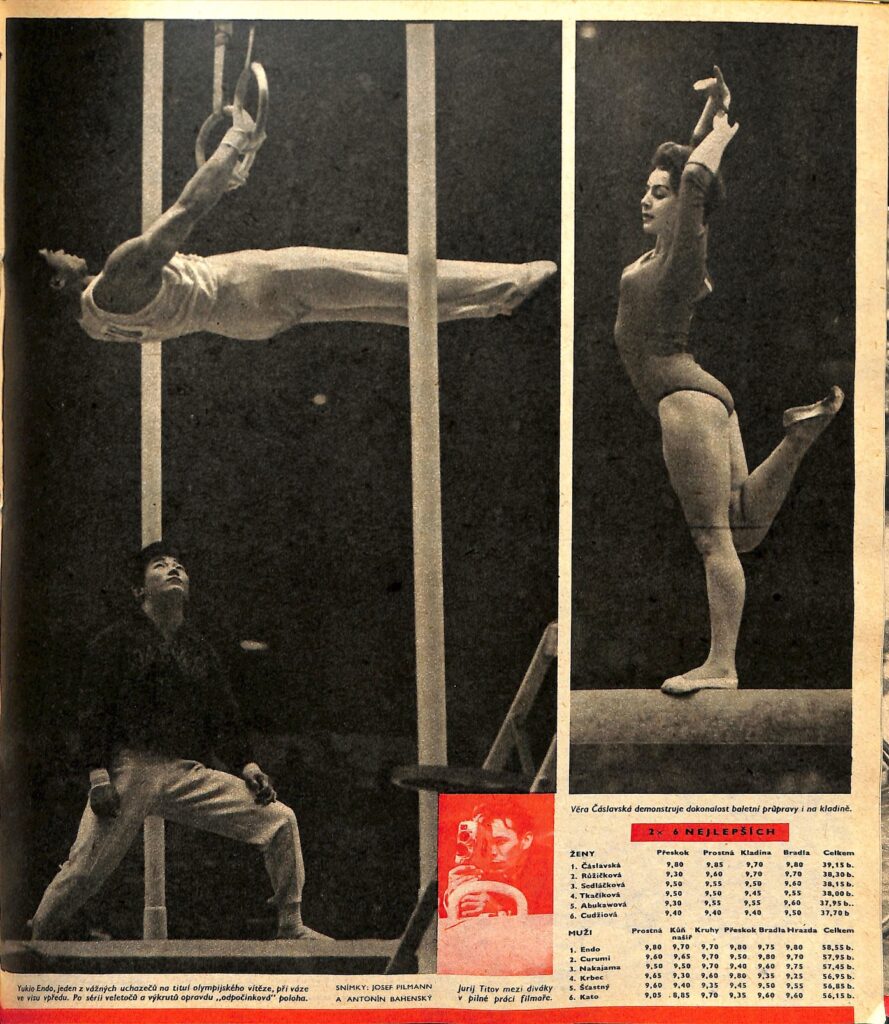In 1963, Japanese gymnasts traveled to Czechoslovakia for a dual meet. Not surprisingly, the Soviets, specifically Yuri Titov, made a trip to Czechoslovakia to film the routines, and the East Germans were there with their notepads.
According to an article in the Czechoslovak sports magazine Stadión, the Japanese men’s artistic gymnasts were breaking new ground on rings and high bar, while the Czechoslovak women’s artistic gymnasts were showing original elements on beam and floor. (Though, the Japanese women’s artistic gymnasts were the queens of turns on beam.)
Here’s a short account of what happened.
Reminder: This was a competition between the top teams in the world. The Czechoslovak men’s team finished third at the 1962 World Championships while the Japanese men finished first. The Czechoslovak women’s team finished second in 1962 while the Japanese women finished third.
Results
Women
| Gymnast | Country | VT | UB | BB | FX | Total |
| 1. Čáslavská | TCH | 9.80 | 9.80 | 9.70 | 9.85 | 39.15 |
| 2. Růžičková | TCH | 9.30 | 9.70 | 9.70 | 9.60 | 38.30 |
| 3. Sedláčková | TCH | 9.50 | 9.60 | 9.50 | 9.55 | 38.15 |
| 4. Tkačíková | TCH | 9.50 | 9.55 | 9.45 | 9.50 | 38.00 |
| 5. Abukawa* | JPN | 9.30 | 9.60 | 9.55 | 9.55 | 37.95 |
| 6. Tsuji | JPN | 9.40 | 9.50 | 9.40 | 9.40 | 37.70 |
Men
| Gymnast | Country | FX | PH | SR | VT | PB | HB | Total |
| 1. Endo | JPN | 9.80 | 9,70 | 9.70 | 9.80 | 9.75 | 9.80 | 58.55 |
| 2. Tsurumi | JPN | 9.60 | 9.65 | 9.70 | 9.50 | 9.80 | 9.70 | 57.95 |
| 3. Nakayama | JPN | 9.50 | 9.50 | 9.70 | 9.40 | 9.60 | 9.75 | 57.45 |
| 4. Krbec | TCH | 9.65 | 9.30 | 9.60 | 9.80 | 9.35 | 9.25 | 56.95 |
| 5. Šťastný | TCH | 9.60 | 9.40 | 9.35 | 9.45 | 9.50 | 9.55 | 56.85 |
| 6. Kato | JPN | 9.05 | 8.85 | 9.70 | 9.35 | 9.60 | 9.60 | 56.15 |


Evenings full of gymnastics
First dress rehearsal for the Olympic premiere with Czechoslovak-Japanese cast • Starring: the women of Czechoslovakia and the men from the Land of the Rising Sun • Admirable Čáslavská and Yukio Endo without competition • Surprise: third place for the young Sedláčková [who was 16 at the time] and fourth place for Krbec in the overall standings • Where to add more effort? • The camera in the hands of world champion Yuri Titov did not rest • The described notepads of the GDR observers • The excessive gallantry of our judges towards the Japanese women • The proverbial courtesy of judge Tsukawaki [Shinsaku] • The only negative: the unnecessary lengthiness of both competitions on both nights
CHARACTERISTICS:
The competition in optional routines between Czechoslovakia and Japan marked the end of the first phase of preparations for the Olympic Games in Tokyo. The duel ended in a draw. In what did the Japanese male gymnasts surpass our athletes? Exactly in the same indicators in which our female athletes surpassed the female Japanese gymnasts: in combativeness, in rich creative imagination combined with supreme difficulty and confidence. If the Japanese are breaking new ground on the rings and horizontal bar, then Czechoslovakia is certainly doing the same in the concept of routines on the balance beam and in the floor exercise.
FROM THE PODIUM:
Věra Čáslavská managed — as Eva Bosáková once did — to separate herself from all our competitors and secured first place in all disciplines. Růžičková liked the balance beam and the uneven bars (difficult element: salto into an inverted straddle hang on the higher bar). She needs a better vault to be balanced, as she lost 0.5 points to Čáslavská! Sedláčková was the first aspirant to complete the team for Tokyo. She was the only one to perform a back flip with a twist on floor. Endo Yukio was unrivalled in the men’s competition, with his lowest score being 9.70 pts on rings where he improvised the routine (perhaps because Yuri Titov was filming!). Tsurumi, Endo’s shadow, shone on parallel bars, where he stuck a perfect one-handed handstand into a series of lightning-paced elements. Twenty-year-old Nakayama stood out well above average on the horizontal bar. Krbec surprised us after the failure in Ostrava. His hecht over the horse was worthy of the title of world champion again. However, weaknesses still show through on horizontal bar, parallel bars, and pommel horse.
A HANDFUL OF PROS AND CONS
Vault: we have role models at home in the world champions. Posner and Perglová have to learn from the speed and length of the vaults. Men’s vaults call for height and dynamism. The innovative vault by Boček was interesting – a front handspring accompanied by a pike after the handspring. Floor exercise: for the women, they cease to be a mere routine and become a significant experience. Top elements of acrobatics are unobtrusively composed into the whole routine, abounding with inventiveness and surprising connections (excellent Tkačíková). Men need to improve the connections and links between the different acrobatic lines. This also applies to the otherwise excellent tumbler Boček. Uneven bars: Here only the Japanese women kept up with our men in the concept of routines, which cannot be said in comparison to our men and Japanese. Perhaps only Gajdoš came close to them. Special mention should be made of Abukawa’s element: after a glide kip, on the higher bar, a hop to a piked hang on the lower bar. Balance beam: The new routines understandably still need thorough training and experience. Sedláčková needs to improve her vaults. Certainly the spinning pirouettes remain the specialty of the Japanese. Rings: the modern technique of the Japanese is based on dynamic power, while here the rings remain too much of a strength apparatus. The finishes of our routines; they looked amateurish compared to the Japanese full-twisting somersaults. Pommel horse: Gajdoš and Pazdera were the only ones who let us remember the tradition of Czechs as excellent fighters on this apparatus. Horizontal bar: this was basically an exhibition of the Japanese and a good school not only for our athletes but also for the trainers.
ABOUT THE PEOPLE AROUND THE STAGE:
The judges in the women’s competition were too benevolent towards the Japanese women, which was generously reciprocated by Mr. Tsukawaki in the men’s competition. For the future, it would not hurt to invite at least one neutral judge. Perhaps one of the many observers could have officiated? The organization was not up to scratch this time, and the program was too long both nights. The traditionally mature audience created a nice framework for this duel between two gymnastic superpowers.
Photo Captions:
Nakayama Akinori, nicknamed “Mourka,” amazes with a turn over the horizontal bar. A straight instructional shot should motivate our coaches.
František Bočko, an aspirant for a place in the Olympic team, is equal to the Japanese in acrobatics. His specialty is the forward salto after the front handspring.
Jaroslava Sedláčková, a 16-year-old junior, is definitely not without international experience. That is why her debut among the elite ended successfully.
Yukio Endo, one of the serious contenders for the Olympic title, doing a front lever. After a series of giant swings and inlocates, a really “relaxing” position.
Věra Čáslavská demonstrates the perfection of ballet training on the balance beam.
Yuri Titov among the audience working diligently as a filmmaker.
Stadión, May 17, 1963
Večery plné gymnastiky
První generálka na olympijskou premiéru s československo-japonským obsazením • V hlavních rolích: ženy ČSSR a muži ze Země vycházejícího slunce • Obdivuhodná Čáslavská a Yukio Endo bez konkurence • Překvapení: třetí místo mladičké Sedláčkové a čtvrté Krbcovo v celkovém pořadí • Kde je třeba přidat? • Kamera v rukou mistra světa Jurije Titova si neodpočinula • Popsané bloky pozorovatelů z NDR • Přílišná galantnost našich rozhodčích vůči Japonkám • Příslovečná zdvořilost rozhodčího Cukawakiho • Jediný zápor: po oba večery zbytečná zdlouhavost obou závodů
CHARAKTERISTIKA:
Závod ve volných sestavách mezi ČSSR a Japonskem byl tečkou za první fází příprav na OH v Tokiu. Souboj skončil nerozhodně, V čem předčili japonští gymnasté naše závodníky? Přesně v týchž ukazatelích jako naše ženy japonské gymnastky: v bojovnosti, v bohaté tvůrčí fantazii spojené s vrcholovou obtížností a jistotou. Razí-li Japonci nové směry při cvičení na kruzích a na hrazdě, pak Československo činí zcela určitě totéž v koncepci sestav na kladině a v prostných.
ZE STUPŇŮ VÍTĚZŮ:
Věře Čáslavské se podařilo — jako kdysi Evě Bosákové — odpoutat se od všech našich
závodnic a zajistila si prvenství ve všech disciplínách. Růžičková se líbila na kladině a na bradlech (obtížný prvek: překot vzad do svisu vznesmo roznožmo na vyšší žerdi).
K vyrovnanosti jí chybí lepší přeskok, kde na Čáslavskou ztratila 0,5 b.! Sedláčková se pasovala na první aspirantku pro doplnění družstva na Tokio. V prostných jako jediná předvedla prohnuté salto vzad s vrutem. Yukio Endo byl v soutěži mužů bez konkurence a jeho nejnižší známka byla 9,70 b. Na kruzích, kde sestavu improvizoval (snad proto, že Jurij Titov filmoval!). Curumi, Endův stín, se zaskvěl na bradlech, kde do seriálu bleskově zacvičených prvků zapíchl dokonalou stoj jednoruč. Dvacetiletý Nakajama vynikl vysoko nad průměr na hrazdě. Z našich překvapil po ostravském neúspěchu Krbec. Jeho letka přes koně byla znovu hodna mistra světa. Slabinky však ještě stále prokukují hrazdou, bradly i koněm našíř.
HRST KLADŮ I ZÁPORŮ
Přeskoky: Vzory máme doma v mistrech světa. Z rychlosti a délky skoků se musí především učit Posnerová a Perglová. Přeskoky mužů volají po výši a dynamičnosti. Zajímavý byl novátorský skok Bočkův — přemet vpřed doplněný schýlením po odrazu rukou. Prostná: U žen přestávají být pouhou sestavou a stávají se výrazným prožitkem. Vrcholové prvky akrobacie jsou nenápadně komponovány do celé sestavy, hýří nápaditostí a překvapivými vazbami (výborná Tkačíková). Muži potřebují vylepšit spoje a a vazby mezi jednotlivými akrobatickými řadami. To platí i pro jinak výborného skokana Bočka. Bradla: Zde jedině Japonky udržely v koncepci sestav krok s našimi, což se ve srovnání s našimi muži a Japonci říci nedá. Snad jediný Gajdoš se jim přiblížil. Zvláštní zmínky zaslouží prvek Abukawové: po vzepření zadem přítrhem, na vyšší žerdi přeskok do prohnutého svisu bent hang na nižší žerď. Kladina: Nové sestavy pochopitelně potřebují ještě důkladné zažití. Sedláčková potřebuje zlepšit skoky. Specialitou Japonek zůstaly jistě točené piruety. Kruhy: Moderní technika Japonců spočívá v dynamické síle, zatímco u nás zůstávají kruhy příliš tahovým nářadím. Závěry sestav našich; vyhlížely ve srovnání s japonskými přemety s dvojným vrutem školácky. Kůň našíř: Gajdoš a Pazdera jako jediní nechali zavzpomínat na tradici Čechů co vynikajících borců na tomto nářadí. Hrazda: To byla pouze exhibice Japonců a dobrá škola nejen pro naše závodníky, ale i pro trenéry.
O LÍDÉCH KOLEM PÓDIA:
Rozhodčí při soutěži žen byly příliš benevolentní vůči Japonkám, což štědře oplácel v soutěži mužů pan Cukawaki. Pro příště neškodilo pozvat alespoň po jednom neutrálním rozhodčím. Snad mohl rozhodovat někdo z četných pozorovatelů? Organizace nebyla tentokrát na výši a program se po oba večery až příliš protáhl. Již tradičně vyspělé obecenstvo vytvořilo tomuto souboji dvou gymnastických velmocí pěkný rámec.
Photo Captions:
Akiumi Nakajama, přezvaný na „Mourka“, udivuje dvojným obratem nad hrazdou. Přímo instrukční záběr by měl podnítit naše trenéry.
František Bočko, aspirant na místo v olympijském družstvu, se v akrobacii vyrovná Japoncům. Jeho specialitou je po přemetu vpřed prohnuté salto vpřed.
Jaroslava Sedláčková, šestnáctiletá juniorka, rozhodně není bez mezindrodních zkušeností. Proto její debut mezi elitou skončil úspěšně.
Yukio Endo, jeden z vážných uchazečů na titul olympijského vítěze, při váze ve vísu vpředu. Po sérií veletočů a výkrutů opravdu „odpočinková“ poloha.
Věra Čáslavská demonstruje dokonalost baletní průpravy i na kladině.
Jurij Titov mezi diváky v pilné práci filmaře.